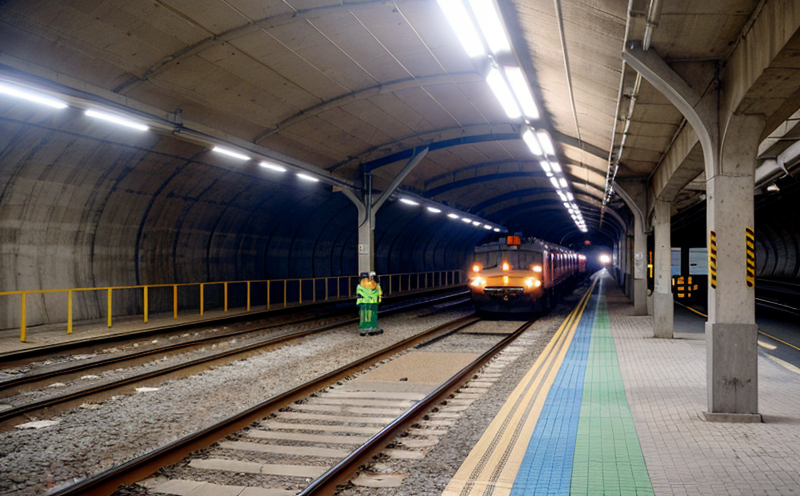EN 1991-2 Load Testing of Railway Bridges under Traffic Loads
The European Standard EN 1991-2 provides a framework for the structural design and assessment of railway bridges. This standard ensures that structures are capable of safely withstanding the dynamic loads imposed by traffic, ensuring public safety and operational reliability. The load testing described in this section focuses specifically on assessing how railway bridges perform under the real-world conditions experienced during regular traffic operations.
The process involves subjecting a bridge to simulated traffic loads that mimic actual train movements. This includes not only the static dead weight of trains but also dynamic effects such as braking, acceleration, and lateral forces generated by wheels interacting with tracks. The testing ensures that the bridge can withstand these stresses without failure or unacceptable deformation.
The test setup typically involves placing load-bearing equipment at strategic points along the span of the bridge to simulate the concentrated loads from train carriages. Advanced instrumentation measures various parameters including deflection, strain, and stress levels throughout the structure during the loading cycle. This data is critical for validating design assumptions and identifying any potential weaknesses that may require remediation.
The significance of this testing cannot be overstated, especially in light of increasing global demand for sustainable infrastructure solutions. Ensuring that bridges can handle traffic loads efficiently not only enhances safety but also supports economic growth by facilitating smooth transportation networks. Moreover, accurate load testing helps minimize unnecessary maintenance costs and extends the lifespan of structures.
Accurate interpretation of test results is essential to ensure compliance with EN 1991-2 requirements. This involves comparing measured values against predefined acceptance criteria outlined in the standard. Compliance ensures that the bridge meets all necessary safety standards, thereby protecting both passengers and infrastructure from potential hazards.
The benefits extend beyond immediate structural integrity; they also contribute significantly to broader sustainability goals by promoting efficient use of resources and reducing environmental impact. By ensuring robustness early on through rigorous testing protocols, we can avoid costly repairs later down the line while maintaining high levels of service reliability for commuters.
- Resource Efficiency: Precise load testing helps identify optimal design parameters which in turn leads to more efficient use of materials and energy during construction phases.
- Economic Benefits: Early detection of issues via thorough testing reduces unexpected maintenance costs over the lifespan of a project.
- Safety Improvements: Accurate assessment enhances overall safety by eliminating any risks associated with structural failures or suboptimal design choices.
In conclusion, adhering to EN 1991-2 standards for load testing is crucial not only for meeting regulatory requirements but also for delivering safe, sustainable, and resilient railway infrastructure. Through meticulous evaluation of real-world loading conditions, this service plays a pivotal role in safeguarding public safety while supporting long-term sustainability initiatives.
Why It Matters
The importance of load testing cannot be overstated when it comes to ensuring the structural integrity and longevity of railway bridges. These structures are exposed to severe stressors over extended periods, including high-speed trains, heavy freight vehicles, and extreme weather conditions. The consequences of neglecting proper load testing could lead to catastrophic failures with dire safety implications for both passengers and staff.
Load testing serves multiple purposes beyond mere compliance with regulatory standards. It provides valuable insights into how bridges behave under actual loading scenarios, allowing engineers to make informed decisions regarding design modifications or additional reinforcements if necessary. This proactive approach helps prevent costly repairs later on by addressing potential weaknesses early in the lifecycle of a project.
From an economic perspective, accurate load testing reduces operational costs associated with frequent inspections and maintenance. By identifying issues promptly through rigorous testing protocols, resources can be allocated more efficiently towards necessary interventions rather than wasteful expenditures on unnecessary upgrades or replacements.
The safety aspect cannot be emphasized enough; every year millions of people rely on railway networks to commute safely and efficiently. Ensuring that bridges are capable of handling expected loads without compromising their structural integrity is paramount for maintaining public trust in these vital transport systems.
In summary, load testing underpins the reliability, safety, and sustainability of railway infrastructure by providing actionable data that informs critical decision-making processes throughout a project’s life cycle. Investing in this service ensures long-term benefits for all stakeholders involved.
International Acceptance and Recognition
The European Standard EN 1991-2 has gained widespread recognition across various sectors, including railway transportation, civil engineering, and construction industries worldwide. Its adoption reflects a commitment to harmonizing design practices and ensuring consistency in quality across different regions.
In the context of railway bridges specifically, this standard has been embraced by numerous countries seeking to establish robust frameworks for assessing structural performance under traffic loads. For instance, many European Union member states have incorporated EN 1991-2 into national codes or guidelines, reflecting its importance in promoting interoperability and standardization.
Moreover, the growing emphasis on sustainable development has further underscored the relevance of such standards in fostering environmentally responsible practices within the industry. By adhering to these internationally recognized benchmarks, organizations demonstrate their dedication to upholding high ethical standards while contributing positively to global sustainability goals.
The endorsement by reputable bodies like CEN (European Committee for Standardization) and ISO (International Organization for Standardization) lends credibility to EN 1991-2 as a leading reference document. These organizations play crucial roles in developing and disseminating best practices that promote innovation, efficiency, and safety across diverse applications.
Compliance with EN 1991-2 is not just about meeting regulatory expectations; it represents an opportunity for companies to distinguish themselves by showcasing their commitment to excellence. Adopting these stringent criteria helps build trust among clients, partners, and stakeholders who value reliability and quality above all else.





